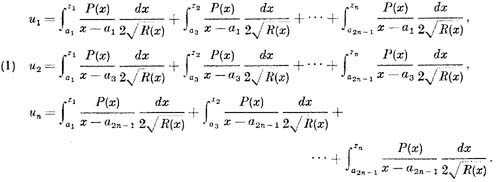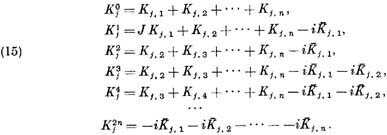Mathematics
Weierstrass’s Al Functions
1
To the system of equations relating integrals ["Integralgleichungen"] from which, according to Jacobi, one must begin in the theory of Abelian integrals ["Abelsche funktionen"], I shall give the following form, which I have recognized to be the simplest and most appropriate one. Let

be a polynomial function of degree

here I assume to begin with that the quantities

are all
real and ordered in such a way that

Now let R(x) be decomposed into two factors,

and

Considering

as independent variables and

as functions of them, let the relations between these 2
n variables be expressed by the following
n equations:

With the help of Abel’s Theorem, I now establish in detail the proposition already stated by Jacobi, which I consider the foundation of the whole theory, namely, that whereas for given values of

the quantities

have infinitely many different values, if, conversely,

are given, then the values of

as well as the corresponding values of

are uniquely determined. Moreover . . .
 are the roots of a
are the roots of a [polynomial]
equation of degree n whose coefficients are . . . single-valued functions of the independent variables
 while a second polynomial function of x, whose coefficients are the same kind of functions of
while a second polynomial function of x, whose coefficients are the same kind of functions of
 gives for
gives for
 the corresponding values of
the corresponding values of

Therefore, every symmetric rational function of

can be regarded as a single-valued function of

In particular, it becomes evident that

where a signifies one of the integers

is the
square of such a function. Accordingly, I denote by

the largest integer less than or equal to
a/2 and set

I also denote

and call the

quantities

etc.,
Abelian functions, since they are the ones which completely correspond to the
elliptic functions
2 sn
u, cn
u, dn
u. The series, expanded in powers of

have the following form:

In these formulas j stands for any one of the integers
 k
k for any of the integers

and

designates a homogeneous polynomial of degree
α. I note generally that
j and
l as well as
j′ and
l′ will stand below for one of the integers
 k
k, on the other hand, will stand for one of the integers

It is to be noted further that wherever there appears the root (of 2nd or 4th degree) of a
positive expression, formed by multiplication and division of the differences

etc., its
positive value shall always be taken.
. . . . .
2.
Now I shall introduce those quantities which are analogous to the so-called complete elliptic integrals of the first kind. If x is real and lies between the limits

and
aα, then

and hence one can set

where all roots are to be taken as positive.
Furthermore, if x lies between + ∞ and a0,

and if x lies between a2n and – ∞:

Now if a and b are two real quantities, and F(x) denotes a rational function of x, then I designate by

that particular value of the integral

which is obtained if in the integration

is always determined by the above formulas, using the upper [positive] sign. Assuming this, let

be designated by

Then the relation

for

holds.
Further, let

so that

where

is to be taken as positive in the first integration,

in the other one. Then it turns out that

A special case of Abel’s Theorem then leads to the following formulas, in which α, β, γ denote numbers from the set

and the symbol

denotes 0 when

and 1 when



From this, one may deduce

and if one sets

where

represent arbitrary integers, then

Now set

and

where

also designate arbitrary integers; one obtains the formulas

where, if

,
m0 must be taken equal to zero; and

in which formula the factor of

is to be set equal to 1 for

With the help of formula (17), one obtains similar relations for the functions

The functions

have the peculiar property ["Eigenthümlichkeit"] that they all have the same singularities ["für dieselben Betrâgen der

unendlich werden"]. Furthermore, as will be shown in the proof of the main theorem given in §1 (if one specifies fixed limits, arbitrarily large, for the absolute values of

which they are not to exceed), each of the mcan be represented as the quotient of two series, expanded in positive integral powers of

which
converge for all values of these variables within the assigned limits. This leads to the conjecture that

might be represented as fractions with a common denominator, in which this denominator as well as the numerators would be functions of

which would never become infinite, and could be expanded in
uniformly convergent series of integral positive powers of their arguments. If

(where
p and
pα are functions of the type just described), then
d log Al(
u1 , . . .) mustconsist of two parts, one of which becomes infinite for all values of

for which

the other, for all those values which cause

to become infinite. The same is the case for the higher logarithmic differentials of

Let us assume now that

where

when

then one can set
du log

and, since
Pα,
P can be expressed in terms of


hence also in terms of

one must arrive in this way at

differential equations for the

quantities indicated.
For elliptic functions, the calculation is very easy. For, if

one has:

Now if one sets

there results

This equation can be factored, giving the two equivalent equations

It has been shown previously that, if the absolute value of u has an upper bound M, sn u can be represented as the quotient of two series of integral powers of u, converging for all values of the variable less than M; hence it can be proved rigorously that the two functions p and p1 defined by the two preceding differential equations can be expanded into uniformly convergent (for all real and imaginary values of u) series of positive integral powers of u. And if the four arbitrary constants which they contain are determined so that, for


then, indeed,

There are similar expansions for cn
u, dn
u, and in this way one arrives at those representations of elliptic functions which Abel had mentioned in a letter to Legendre
3 without giving the details, or any indication of the procedure. From the functions
p and
p1 one also obtains the
Jacobian functions
Θ(
u) and
H(
u) easily, and thus can carry out the development of elliptic functions in all forms without basing them on transformation or multiplication formulas. The above differential equations for
p and
p1 can be made a basis for the complete theory of elliptic transcendental functions.
1 K. Weierstrass "Zur Theorie der Abelsche Funktionen," J. reine ang. Math. 52 (1856), 285–339; Werke, I, 297–355.
2 Like Jacobi, Weierstrass wrote sin am u, cos am u, Δ am u where we have written sn u, cn u, and dn u.
3 See J. reine ang. Math., vol. 4, p. 244; also vol. 6, p. 76 (K. W.)